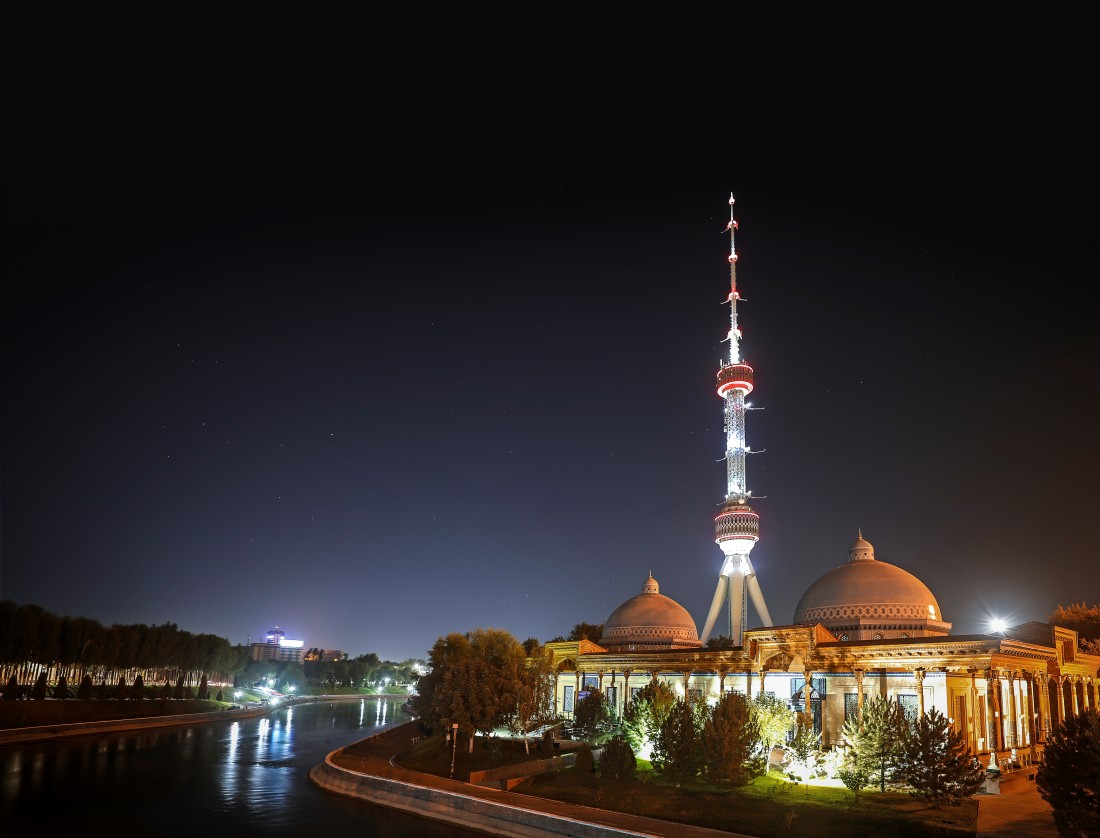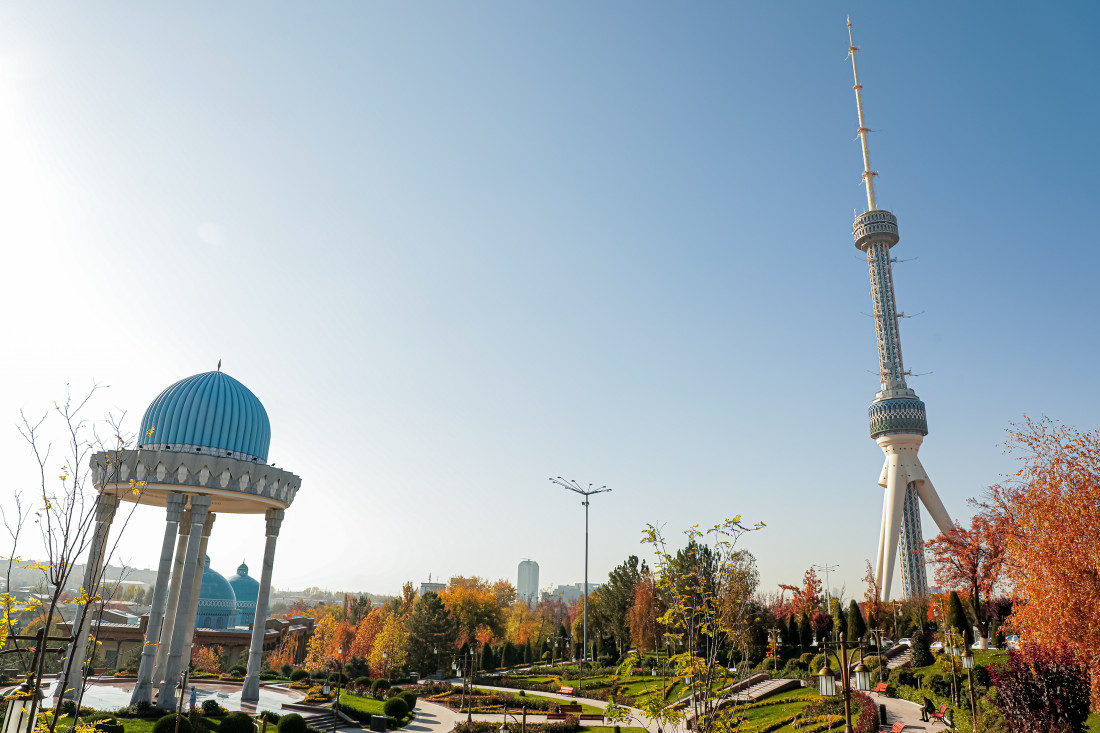
At the end of construction, the height of the television tower became 375 meters, and at that time it was the 4th place in the world in height. Today, occupying an honorable 11th place, the TV tower is part of the World Federation of Great Towers of the World.
Therefore, it is not accidental that the world's tallest TV towers are displayed inside the lower part of the structure, indicating their height and state affiliation. Our skyscraper is favorably distinguished by several features. It has an interesting engineering and architectural-artistic solution.
The unique decision was made by engineers, taking into account the seismic activity of our region there was created an unusual complex lattice structure The tower consists of three parts - the central trunk, trellised frame and tripod. The central trunk, being the main core where the antenna and elevator parts are located, is inserted into the inside of the cylinder (cup) of the hundred-meter tripod. The strut legs of the tripod are embedded in three separate foundations with a diameter of 15 m each.

The foundations of the tower are interconnected by flexible connections - reinforced concrete tapes, on which columns and walls of a technical building are installed.
The metal structures of the tower weighing more than 6000 tons are based on a powerful 11-meter deep foundation.
At the end of construction, the height of the TV tower was 375 meters. At that time, it was the fourth highest tower in the world. Today, the TV tower is part of the World Federation of Great Towers of the World, occupying an honorable 11th place.
Therefore, it is not accidental that the world's tallest TV towers are displayed inside the lower part of the structure, indicating their height and state affiliation.

Several features favorably distinguish our skyscraper. It has an interesting engineering and architectural-artistic solution. Taking into account the seismic activity of our region, engineers made the unique decision and created an unusual complex lattice structure. The tower consists of three parts – the central trunk, trellised frame and tripod. The central trunk, being the main core where the antenna and elevator parts are located, is inserted into the inside of the cylinder (cup) of the hundred-meter tripod. The strut legs of the tripod are embedded in three separate foundations with a diameter of 15 m each. The foundations of the tower are interconnected by flexible connections – reinforced concrete tapes, on which columns and walls of a technical building are installed. The metal structures of the tower, weighing more than 6000 tons, are based on a powerful 11-meter deep foundation. The unique architectural and engineering solutions of the structural part of the tower executed in this way are able to work together under the wind and seismic influence, and the tower as a whole has increased reserves of filling and expenditure of elastic energy without destruction. Such the architectural and engineering solution makes it possible to withstand underground vibrations of 9 points on the Richter scale. The basis of such a constructive solution was the principle of the well-known children’s “roly-poly” toy, that is, the tower can withstand large deviations and, without falling, return to its vertical form. With a strong wind, the tower spire can fluctuate, while the amplitude of the oscillations reaches 10-12 meters. On two levels – 100 m and 220 m the multistory premises – office, technical, meteorological and restaurant surround the tower’s trunk. The antenna part of the tower is located from 223.5 m to 375 m, consisting of pipes of variable diameter from 4 m to 0.72 m, crowned with a flagpole.
The Tashkent TV tower, as a unique architectural structure, is a tourist attraction for visiting by the citizens and the guests of the capital. Reception of the visitors is carried out by excursion service. Guides conduct tours on the history of the TV tower and the sights of Tashkent in Uzbek, Russian and English. To elevate visitors, three high-speed Schindler elevators were installed on the TV tower, lifting people to a height of 100 meters and more in few seconds. A buffet is organized at the observation deck. Photo services are provided for the visitors and the guests of the TV tower as well. From the observation deck, visitors rise to the Koinot restaurant, where two comfortable halls of the restaurant, national Blue and western Red, can accommodate 120 visitors at a time. In addition, here, sitting at beautifully served tables and spinning around the axis for forty minutes, visitors can enjoy the panorama of the city of Tashkent. The light and openwork tower, which has become a symbol of the high technical and cultural level of Uzbekistan, delights visitors and causes pride of Tashkent residents.
From any point of the city, one can see the slender silhouette of the tallest building in Uzbekistan – the Tashkent TV tower. It is located at the highest point of the capital – 486 m above sea level. This is the largest broadcasting centre in the Central Asia, which is a single streamlined technological system, operating around the clock. The system includes the most advanced telecommunication equipment of the world’s leading companies, for the operation of which more than a hundred highly qualified specialists are responsible.
The construction of the Tashkent TV tower was started in 1978, according to the project of architects Y.L. Semashko, N.G. Terziev-Tsarukov and engineers E.P. Morozov, M.D.Musheev. The construction had been carried out by the specialists of the “Vysotstroy” Trust and the Leningrad Department of General Directorate for the Production and Installation of Steel and Precast Concrete Structures (“Glavstalkonstruktsiya”), as well as by more than 30 construction, installation, commissioning and subcontracting organizations for seven years and was completed in January 1985.
Working hours: 9:00 AM - 6:00 PM, Mon-Fri
For any questions
ПОЛЬЗОВАТЕЛЬСКОЕ СОГЛАШЕНИЕ
1. Определение
Настоящее Пользовательское соглашение (далее — Соглашение) является Публичной офертой в соответствии со статьёй 367 Гражданского кодекса Республики Узбекистан от 21.12.1995 (https://lex.uz/ru/docs/111181#162763) и регулирует порядок использования материалов и Сервисов сайта Государственного унитарного предприятия «Национальный PR-центр» (далее — Предприятие), размещённого на веб-сайте и поддоменах Национального Туристического Информационного Центра: https://uzbekistan.travel/ (далее — Сайт).
Посетитель и (или) Пользователь подтверждает, что ознакомлен, полностью и безоговорочно принимает все условия настоящего Соглашения и обязуется их соблюдать.
Использование Сайта Пользователем означает полное принятие данного Соглашения «как есть» в форме акцепта.
Соглашение вступает в силу с момента посещения любой страницы Сайта и (или) регистрации на Сайте и действует бессрочно во время пользования Сервисами Сайта.
Настоящее Соглашение обязательно для исполнения всеми Посетителями и Пользователями без каких-либо изъятий и дополнительных согласований.
Пользователь обязуется самостоятельно проверять актуальную редакцию Соглашения на Сайте перед использованием Сервисов.
2. Предмет Соглашения
Предметом настоящего Соглашения являются правила использования материалов Сайта и предоставление Посетителю и (или) Пользователю возможности использования Сервисов Сайта.
Предприятие является правообладателем исключительных прав на Сайт в целом и на его составные части, включая все виды контента: логотипы, товарные знаки, тексты, статьи, аннотации, иллюстрации, фотографии, графику, аудио- и видеофайлы, пользовательские интерфейсы, дизайн, структуру, программы, базы данных.
Я прочитал(а) и соглашаюсь с условиями использования сайта и политикой конфиденциальности.
